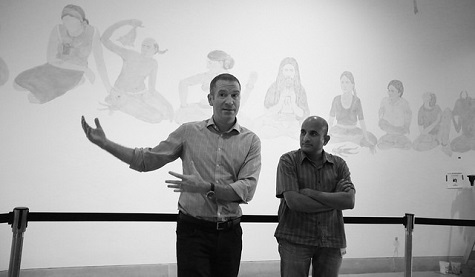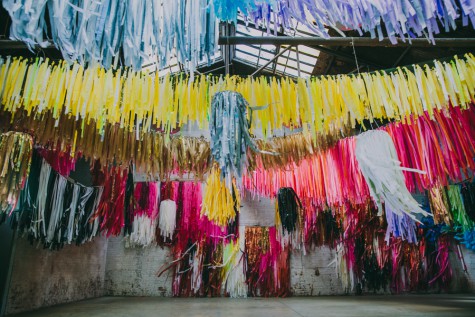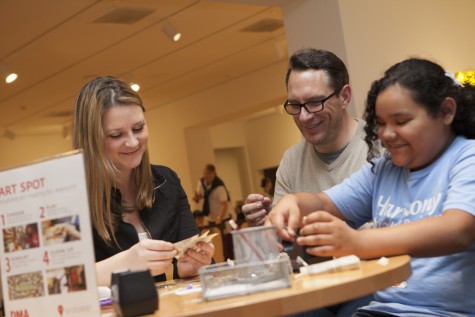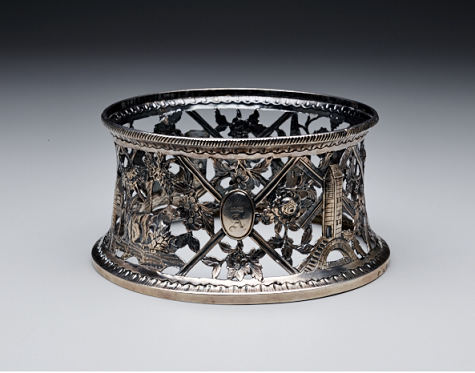This week the DMA unveiled the work Everything is Everything (2006) by the artist Koki Tanaka, which will be on view in the Concourse for the next five months.

The work of Koki Tanaka takes shape primarily as video and installation that explores the relationship between objects and actions. His videos record simple gestures performed with ordinary objects—a knife cutting vegetables, beer poured into a glass, the opening of an umbrella—in which seemingly “nothing happens.” Yet, through their repetitive composition and heightened attention to detail, Tanaka’s videos compel us to take notice of the mundane phenomena of daily life. Latent patterns and geometrical forms emerge out of Tanaka’s work, and otherwise ordinary objects are transformed, providing an epiphany of sorts from moments of everyday life.

Everything is Everything, 2006, eight-channel DVDs, color, sound, and materials in everyday use, installed at Taipei Biennial 2006 in Taipei Fine Arts Museum
(Image courtesy of the artist, Aoyama Meguro, Tokyo, and Vitamin Creative Space, Guangzhou)
The eight-channel video installation Everything is Everything was first created for exhibition at the 2006 Taipei Biennial. For this work, the artist and two assistants spent a total of eight days recording their interactions and interventions with readily available items, including hangers, cups, towels, an air mattress, and toilet paper, all found around the city of Taipei. The physical properties of these objects were tested (a metal hanger is stretched to its breaking point) or their uses were expanded (a level placed on two table legs becomes an impromptu hurdle). Tanaka and his assistants experimented with these objects multiple times, both indoors and in public, and their exploits were compiled into eight distinct video loops ranging in length from 1:19 to 1:50 minutes. Tanaka’s tightly cropped framing of each scene often features the performers from the neck down or removes them from the shot altogether, thus focusing the viewer’s attention on the objects and the simple, repetitive acts being performed.
[youtube=http://www.youtube.com/watch?v=JQQELlWYn4w&w=420&h=315]
In her canonical text, Passages in Modern Sculpture (1981), art historian and critic Rosalind Krauss begins the book’s final chapter with a film by Richard Serra, Hand Catching Lead (1968), in which the artist’s disembodied hand tenaciously attempts to catch pieces of falling lead. Krauss reads Serra’s film as characteristic of minimalist sculpture in the way that it “exploit[s] a kind of found object for its possibilities as an element in a repetitive structure.” The repetitive nature of the actions in Everything is Everything, combined with the use of inexpensive, mass-produced materials, highlights an affinity Tanaka’s videos share with the logic of minimalist sculpture and process art of the 1960s. Similarly, Tanaka’s repetitive use of the objects in Everything is Everything alludes to Serra’s Verb List (1967–68), in which the artist listed eighty-four verbs such as “to roll . . . to crumple . . . to drop . . . to scatter” as a means to relate actions to “oneself, material, place, and process.” Tanaka’s object-oriented work is indebted to minimalism as well as to the legacies of Mono-ha and Arte Povera, as evidenced by a shared interest in exploring the physicality and formal qualities of quotidian objects through processes of encounter and repetition.

Japan Pavilion Photos: Keizo Kioku

Japan Pavilion Photos: Keizo Kioku
Koki Tanaka was born in Tochigi, Japan, in 1975, and currently lives and works in Los Angeles. He received his MFA from Tokyo University of the Arts, Japan, in 2005 and has since been the subject of solo exhibitions at UC Irvine University Art Gallery (2012), the Yerba Buena Center for the Arts, San Francisco (2010), and the Museum of Modern Art, Gunma (2008). Recent group exhibitions include Made in L.A. at the Hammer Museum (2012), the Yokohama Triennale (2011), and Making is Thinking at the Witte de With, Rotterdam (2011). Most recently, Tanaka was selected to represent Japan in the 55th Venice Biennale, for which he received a special mention.
Gabriel Ritter is The Nancy and Tim Hanley Assistant Curator of Contemporary Art at the DMA.














































